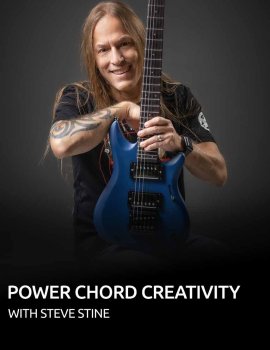 AUDiOZ | 06 August 2021 | 1.57 GB
AUDiOZ | 06 August 2021 | 1.57 GB
Play tons of chords over the entire fretboard, in any position, and in any key, so you could play songs faster and easier.
Power Chords
A power chord is essentially a chord that is missing one of the notes of the triad – the 3rd, the note that defines if a chord is major or minor. It can be played over two or three strings. Let’s see and example starting on the 6th string: the root note, in this case G, is on the lowest string (6th string at 3rd fret), and in case of a 3-string power chord it’s also on the highest string one octave higher.
You can use any combination of fingers that works for you to play these notes. This chord shape can be moved down one string, in this case the root will be on the 5th string.
Moving down another string, we have to adjust the chord shape in order to accommodate for the tuning of the guitar: so the shape of the 4th string power chord will be like this.
In the next chapters we will look at how we can creatively expand these shapes and add different colors to the basic power chord.
Adding The 9th
As a first option we will move the note on the highest string of a 3-finger power chord, which is the root up one octave: by moving it up two frets we can add a 9th to our chord.
Adding The Sharp 5
By moving the note on the second string – the 5th – up one fret we get a very dark sounding chord that can work very well in a metal context, and in fact is widely used by bands like Dokken, Megadeth, Judas Priest and so on.
Adding The Flat 5
Moving the same note in the opposite direction we get another very interesting option, also with a very dark sound.
Descending Movement
The following examples use these expansions to get a descending movement.
Using Power Chord Fragments
By using only the lower two strings of a 3-string power chord we still have a full power chord (because both the root and the 5th are still present), but we can also play an open string and move this fragment to achieve interesting effects.
Moving down one string, some cool sounds in the style of bands like Motley Crue and Iron Maiden can be played.
You can use any finger combination that works for you, including playing both strings with one finger. This ‘inverted power chord’ concept (because now we have the 5th as the bass note) is very widely used – it’s also used in the second part of the Dokken-style example we have seen in the previous chapter.
Heavier Sounding Power Chords
The ‘inverted power chord’ concept can also be used to achieve a fuller sound for our power chords, closer to what we would get if we were using a 7 string guitar. We can add this note to our usual 2- or 3-string power chords when playing on the 5th string
This works when playing chords on the 4th and 3rd string as wel
Adding Major Sound
The power chord can’t be major by definition, but we can use the movements we have seen so far to add a major sound to power chord playing. We have already found an example in the style of Megadeth when looking at descending movement, and ascending movement can also be used.
Adding Minor Sound
The same can be done with the minor 3rd, which is found one fret lower. Looking at all these options, we have a set of possible expansions on the string below the root that can be used.
The following is a great minor sound example in the style of Metallica.
Blues Movements
Moving two frets up from the 5th we have this typical blues sound. We can even stretch 3 frets up to reach the 7th (in our example G).
Changing The Bass
Another option for getting a different sound with power chords.
home page
Password/解压密码www.tbtos.com
Download rapidgator
https://rapidgator.net/file/57410c66d6a2c846bc3d12177a251c3d/0807_23.z01.html
https://rapidgator.net/file/657007968f8b96a623ca9abdfed16905/0807_23.zip.html
Download nitroflare
https://nitro.download/view/ECE4A98921CEC65/0807_23.z01
https://nitro.download/view/8E6D921B124E36B/0807_23.zip
转载请注明:0daytown » GuitarZoom Power Chord Creativity with Steve Stine TUTORiAL